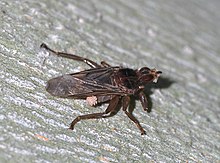Commensalism: Difference between revisions
Tag: repeating characters |
|||
| Line 7: | Line 7: | ||
The commensalism is harder to demonstrate than parasitism and mutualism, for it is easier to show a single instance whereby the host is affected, than it is to prove or disprove that possibility. Usually, a detailed investigation will show that the host indeed has become affected by the relationship. |
The commensalism is harder to demonstrate than parasitism and mutualism, for it is easier to show a single instance whereby the host is affected, than it is to prove or disprove that possibility. Usually, a detailed investigation will show that the host indeed has become affected by the relationship. |
||
NOOOOOOOOO |
|||
=== Cattle egrets and livestock === |
|||
[[Cattle Egret|Cattle egrets]] foraging in fields among [[cattle]] or other livestock is an example of commensalism. As cattle, [[horse]]s and other livestock graze on the field, they cause movements that stir up various insects. As the insects are stirred up, the cattle egrets following the livestock catch and feed upon them. The egrets benefit from this relationship because the livestock have helped them find their meals, while the livestock are typically unaffected by it. |
|||
=== Other examples === |
=== Other examples === |
||
Revision as of 19:46, 16 September 2013

In ecology, commensalism is a class of relationship between two organisms where one organism benefits without affecting the other. It compares with mutualism, in which both organisms benefit, amensalism, where one is harmed while the other is unaffected, and parasitism, where one benefits while the other is harmed.
Commensalism derives from the English word commensal, meaning "eating at the same table" in human social interaction, which in turn comes through French from the Medieval Latin commensalis, meaning "sharing a table", from the prefix com-, meaning "together", and mensa, meaning "table" or "meal".[1] Originally, the term was used to describe the use of waste food by second animals, like the carcass eaters that follow hunting animals, but wait until they have finished their meal.[citation needed]
Examples of commensurable relationships
The commensalism is harder to demonstrate than parasitism and mutualism, for it is easier to show a single instance whereby the host is affected, than it is to prove or disprove that possibility. Usually, a detailed investigation will show that the host indeed has become affected by the relationship.
NOOOOOOOOO
Other examples
Another example of commensalism: birds following army ant raids on a forest floor. As the army ant colony travels on the forest floor, they stir up various flying insect species. As the insects flee from the army ants, the birds following the ants catch the fleeing insects. In this way, the army ants and the birds are in a commensalistic relationship because the birds benefit while the army ants are unaffected.[citation needed]
Arguments
Whether the relationship between humans and some types of our gut flora is commensal or mutualistic is still unanswered.
Some biologists argue that any close interaction between two organisms is unlikely to be completely neutral for either party, and that relationships identified as commensal are likely mutualistic or parasitic in a subtle way that has not been detected. For example, epiphytes are "nutritional pirates" that may intercept substantial amounts of nutrients that would otherwise go to the host plant.[2] Large numbers of epiphytes can also cause tree limbs to break or shade the host plant and reduce its rate of photosynthesis. Similarly, phoretic mites may hinder their host by making flight more difficult, which may affect its aerial hunting ability or cause it to expend extra energy while carrying these passengers.
Types

Like all ecological interactions, commensalisms vary in strength and duration from intimate, long-lived symbioses to brief, weak interactions through intermediaries.
Phoresy
Phoresy is one animal attaching to another exclusively for transportation. This concerns mainly arthropods, examples of which are mites on insects (such as beetles, flies or bees), pseudoscorpions on mammals[3] or beetles, and millipedes on birds.[4] Phoresy can be either obligate or facultative (induced by environmental conditions).
Inquilinism
Inquilinism is the use of a second organism for housing. Examples are epiphytic plants (such as many orchids) that grow on trees,[5] or birds that live in holes in trees.
Metabiosis
Metabiosis is a more indirect dependency, in which one organism creates or prepares a suitable environment for a second. Examples include maggots, which feast and develop on corpses, and hermit crabs, which use gastropod shells to protect their bodies.
See also
- Symbiosis - long-term interactions between different biological species, which can be mutualistic, commensal or parasitic
- Mutualism - where both organisms experience mutual benefit in the relationship
- Parasitism - where one organism benefits at the expense of another
References
- ^ Harper, Douglas. "commensalism". Online Etymology Dictionary.
- ^ Benzing, D.H. (1980) Biology of the Bromeliads. Eureka, California: Mad River Press.
- ^ Durden, Lance A. (2001) "Pseudoscorpions Associated With Mammals in Papua New Guinea". Biotropica, Vol. 23, No. 2, pp. 204–206.
- ^ Tajovy, Karel, et al. (2001) "Millipedes (Diplopoda) in Dogs' nests". European Journal of Soil Biology, vol. 37, pp. 321–323.
- ^ C. Michael Hogan. 2011. Commensalism. Topic Ed. M.Mcginley. Ed-in-chief C.J.Cleveland. Encyclopedia of Earth. National Council for Science and the Environment. Washington DC
